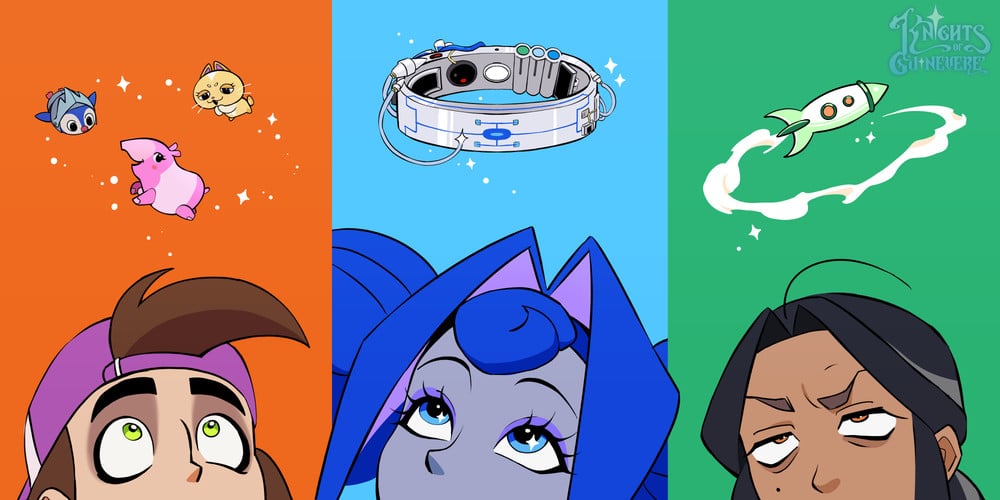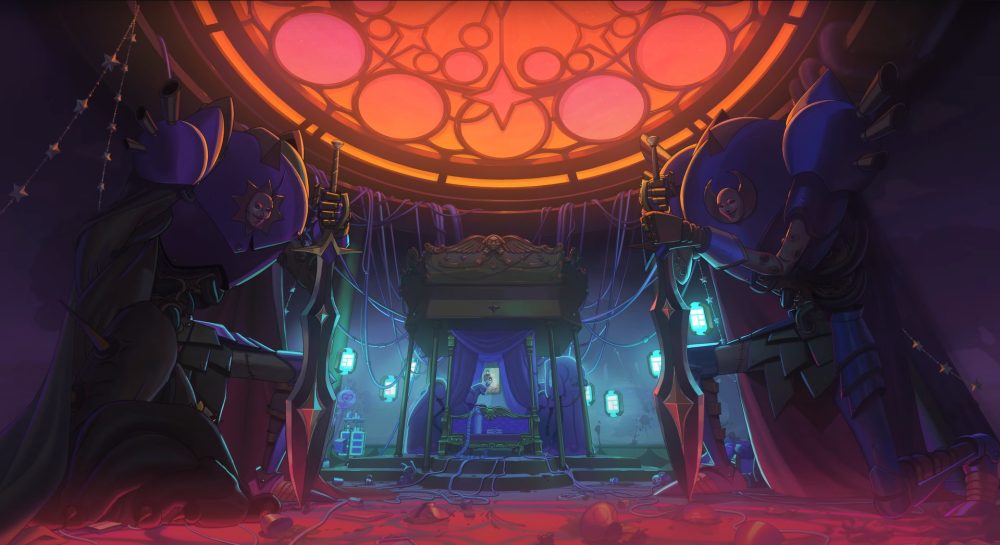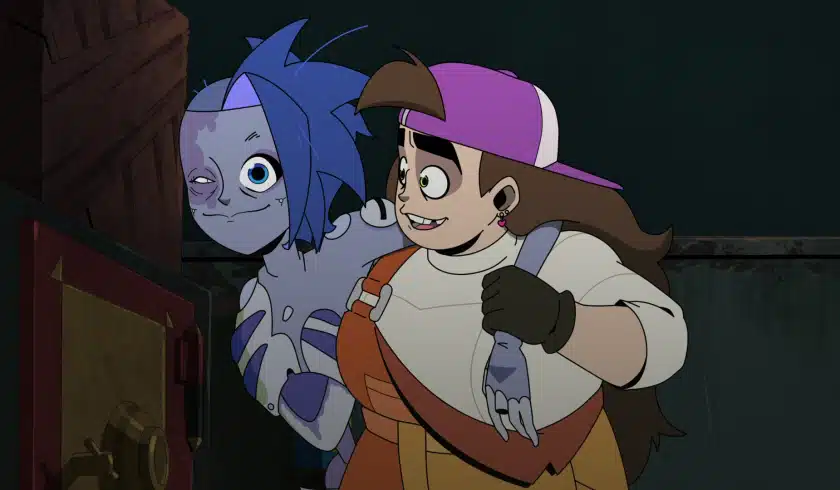Note: This review has spoilers for the pilot episode of Knights of Guinevere.
Me along with at least 100,000 other people were in the YouTube waiting room watching the trailer for Glitch‘s new production, Knights of Guinevere. Helmed by Dana Terrace, John Bailey Owen, and Zach Marcus—all from The Owl House—Knights of Guinevere refuses to pull punches in multiple respects. It’s a psychological horror series surrounding the escape and awakening of a former Disney princess analog Princess Guinevere and her two “knights,” blue collar-worker and dreamer Frankie and jaded engineer Andi.


If you’ve seen the arcs of the overachiever and her best friend trying to keep up with her, then Andi and Frankie’s arcs are very familiar. If you’ve seen any story of the haves and have-nots, same deal. What makes it different is the set dressing and some potentially disturbing questions. It takes place at an interstellar amusement park which is a location rife with Disney analogs and pastiche. However, this is not just a “revenge on Disney” narrative as many people online have called it. It feels more like a narrative about the nature of consumerism and art, the dangers of having dreams, and difficulties of chasing them when you don’t have the proper credentials.
There’s also the question of the android Gwen and what she is exactly. Not to spoil anything but there’s a shot at the end of the pilot that had me asking this openly while watching. There are entire conversations to be had about female characters in media, representation as an aspect of manufactured consent, and why agency through violence is not taken seriously enough when minorities engage with it that I don’t have the time to get into here, but I really hope the show gets into. This is a pilot after all.
This pilot episode does what pilots are supposed to do: they establish the reality of the world and leave a number of questions that will be answered for main series in case it’s greenlit. I’m familiar with pilots. They’re one-shots and opening chapters of a story that ask the viewer (or reader in comics’ case) to buy in. In most cases, pilots make or break a series getting greenlit. In KoG‘s case—where the greenlight is all but guaranteed—this pilot is more of an opening chapter than a pilot proper.
And the opening chapter is good. There are so many concepts introduced that I can’t wait to see in the full show.
The idea of an elderly woman surrounded by childish dolls determined to make her perfect princess right even on her deathbed is such an obvious metaphor for the ways patriarchy asks us to chase unrealistic standards. Also, the way that women reinforce those norm through violence is a nice touch and reminds me of one of favorite books this year, Agustina Bazterrica‘s The Unworthy. The idea of the robotic sentinels coming to kill people who have Guinevere androids outside of the park is fascinating. The design gives off a “Be Not Afraid” eldritch horror vibe to it.


One of my few critiques is how some of the animation and shot compositions are choppy and not thought out. It is the first 2D animated show for Glitch, so there is space for some roughness. I specifically was hoping for transition shots. There’s a moment where the girls get knocked into the water and the next shot is them already out of it that was jarring for me. In my opinion, I’d take shorter episodes if it meant the animation was smoother overall.
However, where the animation may be choppy, the color story is not. Whoever is in charge of compositing did their big one with this show. Its candy colored in a sickly, plasticky way that I love. It feels like a blend of sugary theme park colors and the neons found in cyberpunk films.
Another area I will not be critiquing is the queerness. This show reads as queer to a person who spends most of her time outside of work in queer spaces and ingesting queer media. There were murmurings among Owl House fans about whether not there would be queer romance in KoG. This is especially due to the difficulty that showrunners like Terrace and Steven Universe creator Rebecca Sugar had to get queerness to be shown on screen. With shows like Arcane displaying on-screen sex between women, it feels like the ante in animated sapphic relationships has been raised.
I cannot help but be of two minds on this. One part of me wanted to see a queer romance that fell outside of the stereotypical sapphic partnerships (femxfem, conventionally attractive (no, I will not entertain the false idea that butchfemme dynamics are more accepted in cishetero society than femxfem ones)). Especially in the times that we’re in—where queerness is being legislated out of public life—I hoped to see queer creators not be afraid to swing for the rafters. I feel like they did that with Frankie’s design and arc. Seriously, her whole thing about wanting to save the princess and be rewarded is so fucking butch it hurts.
The other part wishes that queer creators could explore aspects of queer culture that aren’t romantic and sexual without feeling like they aren’t being a queer creator correctly. Things like the depth of our friendships, the fact that we like frogs (including me who literally has Keroppi as my screensaver), or the way that butches are often in blue collar and working class positions, like Frankie, and face abuse from it. Andi and Frankie’s relationship reminds me of queerplatonic relationships that I’ve had in my real life. The inside jokes, the job stress, the implicit understanding between the two of them. That is queer culture. We often are families to each other because we have often have no one else.
I’m leaning more in the second camp than the first, mostly because of the times we are in. My politics are queer in that I don’t need to fit cishetero standards of representation and approval for a piece of queer media to be good enough. In a community who’s idea of attractive are fems, futches and mascs who are smaller than a size 8 and taller than 5’7, what I think is attractive falls outside of that. Is this a roundabout way of saying I think Frankie is hot? Yes and that it’s high time we started showing queerness in all its layers and forms.


Speaking of showing, I love that there’s more showing than telling on screen with this KoG. I had to watch it multiple times to catch certain things, and even catch the QR code that was used in a 2 second shot. Little details like that clue me in that the team wants us to be paying close attention to details in KoG. As someone who delights in media that doesn’t engage in a lot of handholding, this was the highlight of the show for me.
All in all, I think that Knights of Guinevere is off to a good start.


